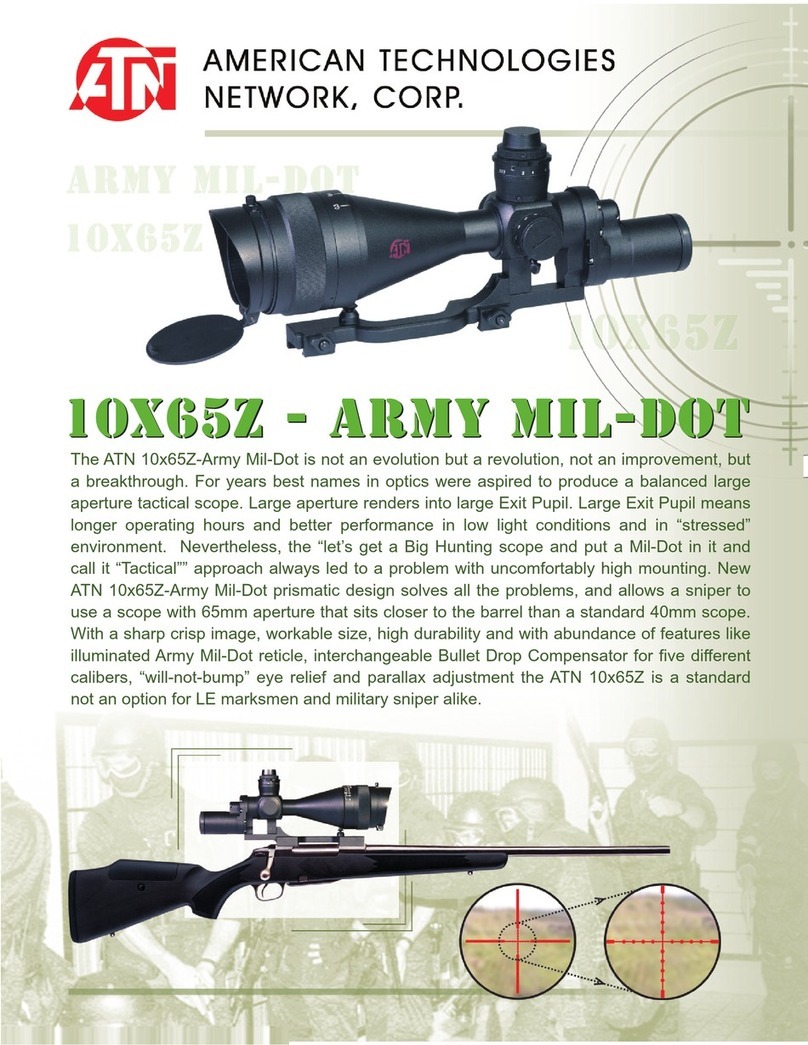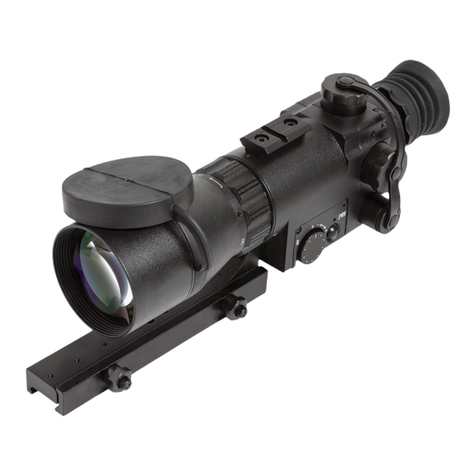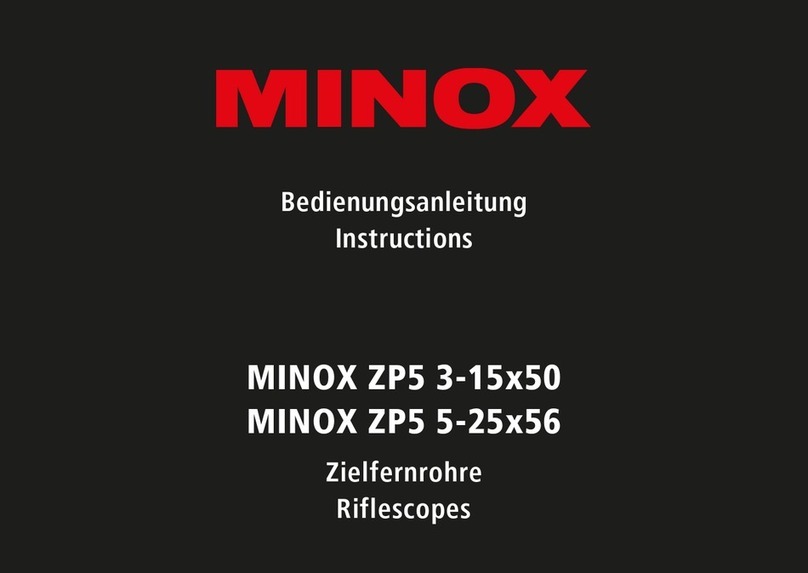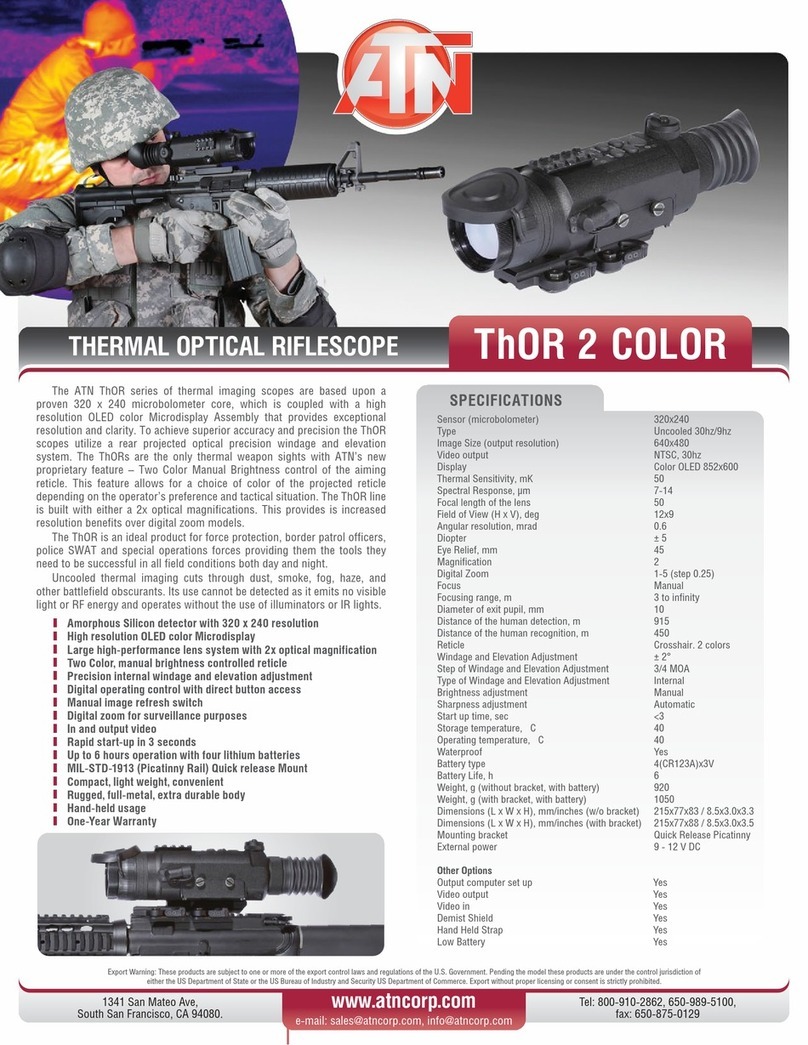AGM PYTHON-MICRO User manual

USER MANUAL
PYTHON-MICRO
THERMAL IMAGING RIFLESCOPE

© 2019 AGM Global Vision. All rights reserved worldwide.
This documentation is subject to change without notice.
No parts of this manual, in whole or in part, may be copied, photocopied, translated,
or transmitted by any electronic medium or in machine-readable form without the
prior written permission of AGM Global Vision.
If you have questions that are not covered in this manual, or need service, contact
AGM Global Vision customer support for additional information prior to returning a
product.
AGM Global Vision
173 West Main Street
PO Box 962
Springerville, AZ 85938
Tel. 928.333.4300
Fax 480.393.4882
support@agmglobalvision.com
www.agmglobalvision.com
EXPORT INFORMATION
Buyer acknowledges that all products supplied by AGM Global Vision are subject to U.S.
export control laws, including, but not limited to, the Export Administration Regulations, the
International Economic Emergency Powers Act, and various U.S. embargoes and sanctions.
AGM Global Vision products may not be exported, re-exported, or transferred contrary to U.S.
export control laws. In particular, AGM Global Vision products may not be exported, re-exported,
or transferred to prohibited countries, individuals, organizations, or entities, including but not
limited to those individuals and entities listed on the List of Specially Designated Nationals
and Blocked Persons administered or maintained by the U.S. Office of Foreign Assets Control
(“OFAC”), the various lists maintained by the Bureau of Industry and Security of the Department
of Commerce, and the U.S. State Department and Buyer represents and warrants that neither
Buyer nor any of its officers, directors, or employees are on such lists. Distribution or resale by
Buyer to such countries, individuals, organizations, or entities is expressly prohibited. Buyer
has and will maintain a positive process to ensure compliance with this Section.
2019.09.13

Python-Micro USER MANUAL 3
LIST OF CONTENTS
TITLE PAGE
Safety Summary 4
1. GENERAL INFORMATION 6
1.1 System Description 6
1.2 Main Features 6
1.3 Main Parts and Components 7
2. OPERATING INSTRUCTIONS 8
2.1 Installation and Mounting 8
2.2 Controls and Indication 11
2.3 Operating 22
3. WARRANTY INFORMATION 23
3.1 Warranty Information and Registration 23
4. SPECIFICATIONS 25
4.1 Specifications 25

4AGM Global Vision
SAFETY SUMMARY
• Read and follow all instructions
• Read all warnings
• Only use the attachments/ accessories specified by the manufacturer
• All service must be provided by the manufacturer
WARNING:
The proper usage of the device is important for safe exploitation!
Therefore read carefully the present manual!
WARNING:
If the device was left in storage for a longer period of time, before exploitation check
its functionality.
WARNING:
Disassembling of the device is prohibited, except in authorized repair centers.
WARNING:
The external optical surfaces should be clean at all times. Touching the optical surfaces
with bare hands is not recommended.
WARNING:
Sand and sea water can damage the optical coatings!
WARNING:
Do not point the device directly at the sun!
WARNING:
Image performance is dependent on scenery and atmosphere conditions. Contrast in
the same image may vary as a function of the time of day due to the effect of the sun.
For example, at sunset objects will have absorbed different levels of heat resulting in
greater temperature differences and better contrast.
WARNING:
When left in storage for a longer period of time, batteries have to be
removed and stored in polyethylene bags to prevent contact with metal.
(It is recommended to recharge the batteries every two to three months.)
WARNING:
When carrying or transporting the device, put the protective lens cap!

Python-Micro USER MANUAL 5
WARNINGS:
Condensation can cause fogging of the optical surfaces! Condensation occurs when
the temperature or humidity changes as follows:
– When moving the device from cold to warm place or vice versa;
– In places with high humidity.
When equalizing the temperature of the device with the environmental, the condensation
disappears. Use the towel to remove moisture.
WARNING:
Clean the lens surfaces with the Lens Cloth or with the napkin!
WARNING:
The IR light from the laser emitter of the Python-Micro TS50LRF range finder is invisible
to the naked eye. However, the light can be detected by all night vision devices (NVD).
To reduce the risk of detection, avoid prolonged activation of the laser.
The IR light is more detectable by other NVDs when used in smoke, fog and rain. Avoid
prolonged activation of the IR laser in these conditions.
WARNING:
NEVER LOOK INTO THE LASER BEAM!
LEGAL NOTICE
Before attaching to weapons, check the regional legal regulations in the area of
application. The attachment to a weapon is always the sole responsibility of the user.

6AGM Global Vision
1 GENERAL INFORMATION
1.1 SYSTEM DESCRIPTION
The AGM Python-Micro TS35, Python-Micro TS50, and Python-Micro TS50LRF are the
compact thermal imaging scopes developed for 24 hours operation under any weather
and environmental conditions. Two modifications of objective lenses allows to choose
perfect unit for your needs where 35 mm lens designed for short range shooting, while
50 mm lens model will be great for medium range missions.
Powered with two CR123 batteries the AGM Python-Micro gives up to 5 hours of
continues work. An external 5V power bank ( battery pack) can be easily connected via
an USB connector for a significant increase of operating time.
The Python-Micro TS50LRF model is equipped with a built-in laser range finder. The
laser range finder is designed to determine the exact distance between the observer
and the target. Measurement results are displayed on display of the thermal riflescope.
1.2 MAIN FEATURES
• Lightweight and compact design
• Easy to operate device
• Automatic or manual (silent) calibration
• High resolution OLED display
• Electronic accuracy correction
• Waterproof, shockproof
• Powered by two standard CR123A batteries
• External power supply capability

Python-Micro USER MANUAL 7
1.3 MAIN PARTS AND COMPONENTS
The Python-Micro is shown in Figure 1-1. The ITEM column of Table 1-1 indicates the
number used to identify items in Figure 1-1.
TABLE 1-1. PYTHON-MICRO MAIN PARTS AND COMPONENTS
ITEM DESCRIPTION ITEM DESCRIPTION
1Lens cover 9Battery compartment cap
2Objective focus ring
10 USB and Video connectors
(closed with a cover)
3Laser range finder (Python-
Micro TS50LRF model only)
4Operation joystick 11 USB cable
5Eyepiece focus ring 12 Video cable
6Eyecup 13 Lens tissue
7Extension interface 14 User manual
8Mount 15 Carrying bag
FIGURE 1-1. PYTHON-MICRO TS50 MAIN PARTS AND COMPONENTS
7
8 9 10
11
12
14
13
15
USER MANUAL
1
2
3
4
56

8AGM Global Vision
2 OPERATING INSTRUCTIONS
2.1 INSTALLATION AND MOUNTING
2.1.1 UNPACKING
The following steps must be completed prior to each mission.
1. Open the carrying bag, remove the device, and verify that all components are
accounted for.
2. Inspect the device for any obvious evidence of damage to the optical surfaces, body,
operation button, etc. Ensure that all optical surfaces are clean and ready for use.
Clean all optical surfaces with a lens tissue.
2.1.2 BATTERIES INSTALL ATION
Turn the battery cover knob clockwise until stop and remove the cover from battery
compartment (see the Figure 2-1, OPEN position). Install two CR123A batteries in
opposite polarity direction (Figure 2-2).
OPEN
Pull
CLOSE
Press
FIGURE 2-1. BATTERY COMPARTMENT
FIGURE 2-2. BATTERY POLARITY

Python-Micro USER MANUAL 9
Turn the battery cover knob counterclockwise until stop. The latches from both sides of
the cover will pull out. Replace the battery cover and press it until its clicking position.
(see the Figure 2-1, CLOSE position). Make sure the cover is closed on both sides.
Battery charge level is displayed on the status bar (Figure 2-3)
WARNING:
Do not use rechargeable batteries since their use causes inaccurate battery level
indication and possible disconnection during operation.
NOTE:
Please do not use batteries of different types or batteries with various charge levels.
2.1.3 INSTALLING THE PYTHON-MICRO ON A PICATINNY/WEAVER RAIL
The Python-Micro can be attached to the Picatinny-style rail. To do this, loosen the
fixation screw of the mount (Figure 2-4, A). Place the scope onto the Picatinny rail, and
verify that the mount aligns with the rail. Tighten the fixation screw.
FIGURE 2-3. BATTERY STATUS BAR
A
FIGURE 2-4. INSTALLING THE PYTHON-MICRO

10 AGM Global Vision
2.1.4 VIDEO CABLE CONNECTION
Video cable serves for the connection with an external display monitor. Install the cable
refer to Figure 2-5.
Open the cover of the Python-Micro connectors. Plug the cable to the mini-jack 3.5mm
connector.
2.1.5 USB CABLE CONNECTION
The external power source can be used for Python-Micro extended operational time.
Connect the external battery as follows (refer to Figure 2-6):
1. Open the cover of the Python-Micro connectors.
2. Plug the USB cable to the micro-USB connector of the Python-Micro. Plug the other
end of the cable to the external battery.
The USB cable also enables updating the device’s firmware to the latest version.
Contact your local distributor for update service.
FIGURE 2-5. CABLE CONNECTION
FIGURE 2-6. EXTERNAL BATTERY CONNECTION

Python-Micro USER MANUAL 11
2.2 CONTROLS AND INDICATION
2.2.1 CONTROLS
ATTENTION:
The main operations are performed through the operation joystick.
The Python-Micro controls are shown in Figure 2-7. The ITEM column of Table 2-1
indicates the number used to identify items in Figure 2-7.
ATTENTION:
Turn off the device after usage, otherwise you can permanently damage the batteries!
1
2 3
FIGURE 2-7. CONTROLS

12 AGM Global Vision
TABLE 2-1. CONTROLS
ITEMS CONTROLS OPERATING MODE FIRST SHORT PRESS LONG PRESS
1Joystick
Button
Push
Real time image Bring out quick menu
ON / OFF
Quick menu NUC
Main menu Confirm selection
LRF Mode
Joystick
Up
Real time image Bring out
quick menu
Enter main
menu
Quick menu Change parameters
Main menu Change parameters
LRF Mode Distance reading
Joystick
Down
Real time image Bring out
quick menu
NA
Quick menu Change parameters
Main menu Change parameters
LRF Mode Distance reading
Joystick
Left
Real time image Bring out
quick menu
NA
Quick menu Switch function
Main menu Select Setting
Options
LRF Mode Distance reading
Joystick
Right
Real time image Bring out
quick menu
NA
Quick menu Switch function
Main menu Select Setting
Options
LRF Mode Distance reading
2 Focus Ring Focuses the objective lens for the sharpest image
3Eyepiece Focus
Ring
Adjusts the eyepiece diopter
2.2.2 STATUS BAR
The status bar is located in the lower part of the display (Figure 2-8) and shows
information about an actual operating status of the sight, including:

Python-Micro USER MANUAL 13
1. Color palette: WH (White Hot), BH (Black Hot), C1~C10.
2. Zeroing profile A/B/C/D/E.
3. Rangefinder distance display.
4. Current digital zoom magnification.
5. Battery charge with current level in percent.
2.2.3 QUICK MENU
The Quick Menu allows change of basic settings. Enter the Quick menu with a
short press of any button in Up/Down/Left/Right. To toggle between the functions
below, press Left or Right button when Quick menu is in display. If select of Zoom,
Palette, Brightness, Contrast, Sharpness functions do not take place in 5 second, the
information disappear from display.
ZOOM
Press the Up/Down buttons to change digital zoom from 1X, 2X, 4X, and PIP.
Picture in inset window under PIP mode is 2X digital zoom.
PALETTE
Basic image mode is “White Hot”. Press the Up/Down buttons to select palette
C1~C10.
BRIGHTNESS
Press the Up/Down buttons to change image brightness from 0~9.
CONTRAST
Press the Up/Down buttons to change display contrast from 0~9.
SHARPNESS
Select one of the sharpness aside with a short press of Up / Down.
MANUAL(SILENT) CALIBRATION
Close the Lens Cover before calibration.
1 2 3 4 5
FIGURE 2-8. STATUS BAR

14 AGM Global Vision
STADIAMETRIC RANGEFINDER
Python-Micro riflescopes are equipped with a stadiametric rangefinder which allows
the user to estimate approximate distance to an object of known size.
You will see on the display: measurement bars, icons of three reference objects and
respective distances for the three objects.
There are three pre-set reference objects:
Hare - height 0.3 m
Wild boar - height 0.7 m
Deer - height 1.7 m
The lower fixed bar under the object automatically appear on display, press the Up/
Down buttons to move the upper horizontal bar until the object fits entirely between
the two lines. The distance to the object is automatically recalculated as you move the
upper line.
Press Left/Right buttons to choose reference object, press Middle button to exit
rangefinder mode, range information will not disappear from display automatically.
Distance to the object displays in status bar and a “> < ” on reticle suggests the aiming
point accordingly.
To select the unit of measurement (meters or yards), go to the respective menu option.
FIGURE 2-9. STADIAMETRIC RANGEFINDER

Python-Micro USER MANUAL 15
LASER RANGE FINDER (Python-Micro TS50LRF only)
The Python-Micro TS50LRF model is equipped with a built-in laser range finder. When
under real time image mode, press right button to enter range finder mode, then press
UP/DOWN/LEFT/RIGHT, the corresponding distance of target appears on display.
Press Middle button to exit Laser rangefinder mode.
Range information will not disappear from display automatically.
Distance to the object displays in status bar and the marks “> <” on reticle suggests
the aiming point accordingly.
FIGURE 2-10. LASER RANGE FINDER
FIGURE 2-11. AIMING POINT MARKS ON THE RETICLE

16 AGM Global Vision
2.2.4 MAIN MENU
NOTE
Enter the main menu with a long press of the Up button. Press the Left/Right buttons
to select between the main menu options.
All menu is displayed in the central area of the image. The reason is the reduced field of
view of the day sight by higher magnifications. Reaching a low battery state the device
gives a warning in the top left corner of the central area.
EXIT
Press the Up/Down button to Exit, the Main Menu will not disappear
automatically.
AUTO NUC
Press the Up/Down button to turn Automatic Non-uniformity Calibration On /
Off. In the automatic mode the need for calibration is based on software
algorithm, calibration starts automatically. When choose Off, user will do
calibration manually by either lens cover(silent without shutter) or press middle
button(with shutter). Manual calibration function is in Quick Menu.
OLED BRIGHTNESS
Press the Up / Down buttons to change OLED brightness from -2, -1, 0, 1, 2.
UNIT
Press Up/Down to select units of measurement from Yards and Meters.

Python-Micro USER MANUAL 17
DEFECTIVE PIXEL REPAIR
Press Up/Down buttons then close lens cover to repair defective pixel. Defective
pixels are found by software algorithm.
RETICLE
This main menu option allows you to select reticle shape and color. Enter
submenu of “Reticle Setup” with a short press of Up/Down and you will see:
Select the desired reticle shape out of the list of 5 reticles with Up/Down.
Press Right to move the Reticle Color selection.
Select the desired reticle color Black, White, Red, or Green with Up/Down.
Press Right to move to back.
Press Up/Down to return to real time image with the reticle type and color
you just chose.
M1 CE
D
RETICLE
PARAMETERS
MOA / CM @ 100 M
(35MM) (50MM)
Section A 0.58 / 2.4 0.58 / 1.7
Section B 0.58 / 2.4 0.58 / 1.7
Section C 5.8 / 2.4 5.8 / 17
Section D 5.8 / 2.4 5.8 / 17
Section E 37.7 / 15 6 37.7/ 110.5
A
B

18 AGM Global Vision
ZEROING PROFILE
Various profiles can be used when employing the sight on different rifles and
when shooting different cartridges. Select one of the zeroing profiles (shown
with letters A, B, C, D, E) with short press Up/Down. The name of selected
profiles is displayed in the status bar.
M2
D
FG
E
A
B
C
RETICLE
PARAMETERS
MOA / CM @ 100 M
(35MM) (50MM)
Section A 2.9 / 12 2.9 / 8.5
Section B 2.9 / 12 2.9 / 8.5
Section C 0.58 / 2.4 0.58 / 1.7
Section D 6.38 / 26.4 6.38 / 18.7
Section E 11.6 / 48 11.6 / 34
Section F 4.06 / 16.8 4.06 / 11.9
Section G 26.68 / 110.4 26.68 / 78.2
M3
E
D
F
A
B
C
RETICLE
PARAMETERS
MOA / CM @ 100 M
(35MM) (50MM)
Section A 2.9 / 12 2.9 / 8.5
Section B 2.9 / 12 2.9 / 8.5
Section C 0.58 / 2.4 0.58 / 1.7
Section D 29/ 120 29 / 85
Section E 58 / 240 58 / 170
Section F 46.11 / 19.08 46.11/135.15
M4
A
B
C
RETICLE
PARAMETERS
MOA / CM @ 100 M
(35MM) (50MM)
Section A 2.9 / 12 2.9 / 8.5
Section B 2.9 / 12 2.9 / 8.5
Section C 0.58 / 2.4 0.58 / 1.7
M5
A
B
RETICLE
PARAMETERS
MOA / CM @ 100 M
(35MM) (50MM)
Section A 0.58 / 2.4 0.58 / 1.7
Section B 0.58 / 2.4 0.58 / 1.7

Python-Micro USER MANUAL 19
ZEROING
To zero your weapon, you need to set a zeroing distance first. You can zero your
weapon at any distance range from 1 to 999m. Enter submenu of “zeroing” with
a short press of Up/Down and you will see:
Select profile icon and press Up/Down. You will see:
Set the value for each digit with press the Up/Down. Switch between the digits with a
short press of Left/Right.
To clean the distance press Left/Right to move to , then short press Up/Down.
To confirm distance press Left/Right to move to , then short press Up/Down.
The distance you set shown above the status bar:
To add another distance, press Left/Right to move to profile icon . Select profile icon
and repeat the operations described above.
NOTE:
Max number of zeroing distances is 5 for each profile.

20 AGM Global Vision
OPERATE THE DISTANCE
Press Up/Down on distance icon, you will see:
Take a shoot, move Up/Down/Left/Right to make cross center of reticle at point of
impact. X, Y will show the distance value you move.
Press middle button to Freeze and you will see:
Save
Press Up/Down to Save, you will see indication:
Back
Press Left, then short press Up/Down to return.
Delete
Press Left/Right, then short press Up/Down
to Delete, you will see indication:
NOTE:
In order to get precise ballistic trajectory, zeroing in 3 distances and 3 shots in each
distance is recommended, and your shortest distance should be no more than 100
meters.
Table of contents



